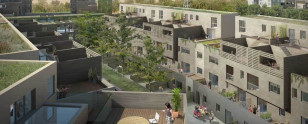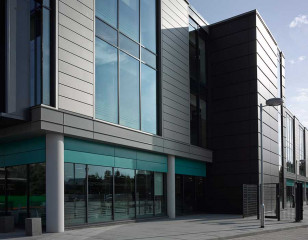Green roofs provide a wide range of benefits to the built environment and they are generally defined as being either ‘extensive’, ‘biodiverse’ or ‘intensive’, terms that indicate their functional use. However, their use also affects the components used in the construction of both the roof itself and the structure of the building.
Eco Green Roof System
SIG Design & Technology have partnered with Eco Green Roofs to provide guaranteed green roof and blue roof systems. Partnering with Eco Green Roofs allows SIG to offer a full built up system which combines expertise on both the green roofing and waterproofing under one package.
Eco Green Roofs provide guaranteed systems that replicate the natural growing environment for plants, creating lush, vibrant, bio-diverse environments that can transform both new and refurbishment projects.
Designing bespoke systems to meet the client’s needs, Eco Green Roofs specialise in the supply and installation of sustainable green roofs, providing technical expertise that is backed up by published academic research.
Green roofs can be built in many different ways, using a variety of materials.
Vegetation Layer
Green roofs can have a variety of planting options. Eco Green Roofs supply many different vegetation layers ranging from fully established blankets (sedum, wild flowers or grasses) that roll out like turf, plug plants, seeds and cuttings.
Substrate
Substrate (the growing medium), is the most important component of a green roof. Eco Green Roofs substrate has been carefully designed for each planting type. Fundamentally it must contain low levels of nutrients to keep the plants easy-to-maintain, hold a certain level of water yet be free-draining to prevent root rotting and have a granular texture to keep the plant roots well aerated (vital for plant health). Substrate design is a science and a lack of knowledge is why a large number of green roofs fail. A good substrate supports the whole green roof system and sustains the vegetation layer.
Filter Layers
Filter layers are very important in a green roof system. They hold the nutrients and fines within the system and stop them from being washed away by the rain.
Drainage layers
Eco Green Roofs have designed a range of drainage layers to complement the roof build-up and function effectively by draining excess water from the roof. Some of the larger drainage layers will also hold a reserve of water in specially designed cups so plants have access to it in drier periods. When needed, the roots will draw the water up by using evapotranspiration.
Root Barrier
A root barrier is used to separate the green roof system from roofing membranes. Generally, Eco Green Roofs install root barriers on roofs that have been retrofitted with a green roof or if certain roofing membranes require extra protection.
Three ways to achieve your green roof
Sedum Roofs
Eco Green Roof sedum systems have been designed with between 8-12 sedum species per meter square. The sedum blankets are grown for over 12 months to ensure the plant roofs are well established and robust enough for roof level. We provide the sedum systems in blanket, plug plant, cuttings and seeded options. Eco Green Roofs source from several sedum farms across the UK.
Wildflower Roofs
Wildflower systems provide more diverse plant communities than sedum roofs. They are particularly favoured when ecological, aesthetic and environmental function needs to be considered. Wildflower blankets are pre-established for a minimum of 12 months and include up to 50 UK native wildflower, herb and grass species. Eco Green Roof wildflower mats and plug planted systems are easily installed for immediate visual impact.
Bio-diverse / Brown Roofs
Bio-diverse or brown roof systems are specifically designed for biodiversity by offering a broad range of annual and perennial wildflower and grass species and providing a mosaic of habitat opportunities for important invertebrate and bird species. These roofs are created for species important to the site or regional bio-diversity plan’ and incorporate several different substrate types placed at different depths to produce undulating (or a contoured effect). Log, stone and sand piles are added for further interest and give areas of shading on a micro level.













